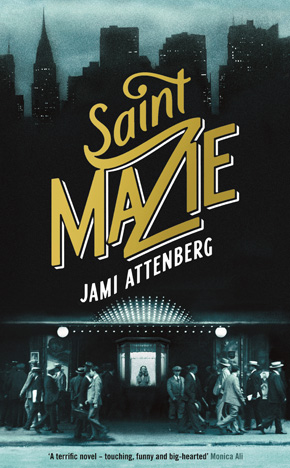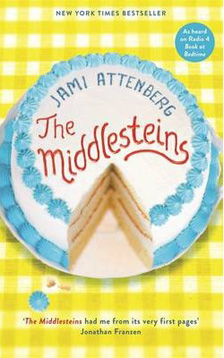Jami Attenberg: How to be
by Lucy Scholes
“A raw, boisterous, generous novel with a heroine to match and New York in its soul.” Maggie Shipstead
Jami Attenberg’s new novel Saint Mazie tells the fictionalised story of one of Manhattan’s real-life heroes of the early 20th century: Mazie Phillips-Gordon, the brassy, big-hearted proprietress of the Venice movie theatre in the Bowery who spent most of her adult life helping the homeless. In 1940 Joseph Mitchell profiled Mazie for the New Yorker – a piece that’s included in his essay collection Up in the Old Hotel – and although Mitchell’s portrait was an invaluable source for Attenberg when she was writing the book, her first introduction to Mazie actually came by way of a friend of hers who was opening a bar in Brooklyn and planned to name it after this mostly forgotten figure. Having heard about Mazie’s incredible life, Attenberg was intrigued, starting her research the very next day, and thus the two endeavours ran side by side: Attenberg writing the novel; and her friend building the bar.
She describes Up in the Old Hotel as a “fiction writer’s dream; a writer’s prompt if you’re into that era, New York City, and the people on its streets.” Thus anyone familiar with the work will pick up on the many little references taken from the other essays in the collection that she’s threaded through Saint Mazie. One of the great things about Attenberg’s novel is how it deals with the historical details necessary for a convincing period piece. This is Jazz Age Manhattan, an era of Prohibition, gangsters and gamblers and the Great Depression, and this background is there, but it never obscures the characters. They’re the stars of the show and nothing’s getting in their way.
“I now have an interest in that era,” Attenberg explains, “but I certainly wasn’t someone who dressed up as a flapper for Halloween or anything. I felt like I was grudgingly doing the research. The oral history part of the book is a nod to that. I didn’t want to put in detail just for the sake of getting it in. Plus, a third of the book is not even set in that time.”
This oral history element takes the form of the framing of Mazie’s story by the investigations of Nadine, a documentary filmmaker researching Mazie’s life in 2000 who interviews various people who either knew or have a connection with Mazie. These interviews are interspersed with Mazie’s own diary entries (written between 1907 and 1939) and extracts from her unpublished autobiography; sometimes sitting neatly side-by-side, offering a different perspective on an event, sometimes illuminating details that Mazie herself doesn’t, or can’t address in full. It’s not uncommon for writers fictionalising the story of a real-life figure to blend fact and fiction in their pursuit of as in-depth a portrait as possible, and although on first glance it looks like Attenberg has adopted this form, in actuality every word in the book is the product of Attenberg’s imagination; every source is fictional.
“At first it was very frustrating,” Attenberg says of the lack of material available about Mazie’s life as she struggled to find what little had made it into the historical record, “but then it became very freeing as I realised I could make up everything I wanted.”
The extracts from the unpublished autobiography, for example, all come from Attenberg’s first draft of the project, an 80-page first-person memoir written from Mazie’s perspective. Once she’d written this, she didn’t really know where it was going, she explains. Mazie’s voice alone wasn’t enough. “I think that’s why the oral history part is important, if it was her alone it wouldn’t work; it would just be her being great, like a Lifetime Movie of the Week.” Though she readily admits that this first draft was an important part of the book’s genesis: she had to write those initial pages “to get to know” her protagonist.
It used to be that books told you how to be… with Saint Mazie I was interested in showing the right way. I want people to see compassion as a possibility and that’s why I was attracted to her.”
This is the first time she’s turned to reality as inspiration for her work. “I’ve never had any interest in taking a real character and turning them into fiction before,” she explains, “I already have a lot going on in my head, I just felt that she was going to be this lost hero. She’s already a lost hero. And a lost female hero at that.”
That said, she doesn’t even necessarily see the novel as historical fiction. In fact, if anything it was Mazie’s modernity that initially captured Attenberg’s attention. “She felt so modern when I read about her. That’s what struck me – she felt like someone I would know. Thus for me it’s a young novel. Mazie’s in her twenties, she’s having affairs, she’s running around the streets, she’s someone who would probably never call herself a feminist but is fully a feminist and a really unconventional person.”
Unconventional is definitely the word. As a young woman Mazie has a bit of a reputation as a ‘good-time girl’, so much so in fact that her older sister Rosie and her husband Louis (who have brought up Mazie and her younger sister Jeanie since saving them from an unhappy and violent home in Boston) attempt to keep her in check by giving her a job at Louis’ movie theatre, trapped all day in the tiny glass-fronted box out front selling tickets. It’s a move that Mazie initially resents: “The world will pass me by. I will grow old and then die in that cage,” she bemoans in her diary. But pretty soon she grows to embrace the job, and it’s from this vantage point that she gets to know the people on the streets, the people she’s soon helping out – a kind word, a bar of soap, change from her purse, even a free seat in the cinema in order that they might while away an afternoon in relative warmth and comfort – and by the time the novel ends at the tail end of the 30s, Mazie’s working all day then patrolling the streets at night, often the only one looking out for those everyone else has forgotten:
“And everybody wants to be remembered, don’t they? Everybody wants one little piece of them to be left behind. Well, I remember them. I remember them all. They were nobody to nearly everybody, but they were somebody to me. I knew all their names. Everybody’s names. I knew them all.”
Writing about “that sense of community” appealed to Attenberg, she tells me. Place is very important in the novel – Mazie is ‘Queen of the Bowery’ and lives all over the Lower East Side throughout the 20s and 30s, from Grand Street to the then newly built Knickerbocker Village, with a stint in Coney Island in between.
“NYC is really just a series of small towns next to each other,” Attenberg explains, speaking from experience. Williamsburg has been her home for over a decade now, though she does have a habit of escaping the concrete jungle for three months each year. Most recently New Orleans has become something of a winter retreat, and it’s a city she feels so at home in she’s thinking of moving there more permanently in the future.
Would she describe it as a New York novel? The jury’s still out as far as I’m concerned; the city is clearly integral to the narrative but it’s so character-led I can’t help but see it more as background rather than taking a role of its own centre-stage.
“I honestly didn’t think I was writing a New York novel as I’d already written one,” she tells me. “The Kept Man was my Brooklyn novel, and then I wrote two novels set in the Midwest, so I didn’t think, ‘Hey, it’s time to go back to New York,’ because it’s such a monster of a city and so hard to capture.”
In as much as one might describe the end result as a love letter to the city, this wasn’t her original intention. “I think it was the same with all of my characters,” she says intriguingly, “when I start out, I don’t really like them, but by the end, I do. A lot of my characters are like that. I think even with Mazie – she’s a bad girl and very self-involved at the beginning of the book – I wanted to write about how she became the charitable person she was. I think it was the same with New York, I figure out a way to love everything by the end of my books.”
 Although it’s her fifth title, Saint Mazie is only the second of Attenberg’s novels to be published here in the UK. Her first three books were reviewed warmly, but it was her fourth, The Middlesteins, the tale of a woman obsessed with food and the havoc this wreaks on her and her family, that became a New York Times bestseller. Given its success, was she at all daunted by the prospect of what to write next? Not as such, she says, but she did realise that she had to grasp the opportunity such acclaim afforded her.
Although it’s her fifth title, Saint Mazie is only the second of Attenberg’s novels to be published here in the UK. Her first three books were reviewed warmly, but it was her fourth, The Middlesteins, the tale of a woman obsessed with food and the havoc this wreaks on her and her family, that became a New York Times bestseller. Given its success, was she at all daunted by the prospect of what to write next? Not as such, she says, but she did realise that she had to grasp the opportunity such acclaim afforded her.
“I didn’t want to rest. I thought this is an opportunity. I toured for about a year, and I met people who were deeply affected by the book – whether in the form of their experience of a dysfunctional family, or their or a family member’s complicated relationship with food – it was the first time I’d had a wider reach. So I really thought about what I wanted to say, and what I wanted people to hear when it came to my next book; what people were going to take away from it.”
There’s a very simple but important central message to Saint Mazie, about helping others and doing one’s best to be a good person, the kind of moral that’s absent from many books today.
“I think that in literary fiction you don’t read it a lot, and there’s certainly many books out there about being positive and kind but don’t get taken as seriously by critics. I don’t really know why. It used to be that books told you how to be. With The Middlesteins, in a way it’s showing you the right way to be by showing you the wrong way to be. And so with Saint Mazie I was interested in showing the right way. I want people to see compassion as a possibility and that’s why I was attracted to her.
“I love dark books, cynical books,” Attenberg continues, “but my favourite books are the ones where I put them down and I’m like, ‘I need to become a better person.’ So I wanted to look at this woman who was an inspiration, to meet her, and learn about her.”
For all her good works, and for Attenberg’s central message, Saint Mazie never tips over into the saccharine. Partly because Mazie is a very real character – a bold, brash modern woman often living precariously for her time given society’s expectations for a woman back them; someone who doesn’t live like a saint, far from it on many an occasion in fact – and partly because the true extent of her charitable nature emerges piecemeal over the course of this portrait of thirty-odd years of her life. As one of the interviewees who knew Mazie in her heyday puts it towards the end of the book, by the early 30s when she started walking the streets at night looking after the bums everyone else was ignoring, “she was just starting to become the person she was going to be.”
I want to know whether she showed her work in progress to her friend the bar owner as they each worked on their own Saint Mazies. No, she says, but they did get together and talk about her.
“We gossiped about her in this really weird way,” she says with a laugh. “I remember one conversation in particular about the time when I was still on the cusp of breaking through, of figuring it out, and he’d just opened the business so was working hard on bringing in the clientele, and we were like, ‘Mazie wouldn’t have griped. What are we doing? We’re writing a book; we’re opening a restaurant. This woman walked the streets and helped people for twenty years of her life.’ It puts things into perspective.”
 Jami Attenberg’s previous books are the story collection Instant Love and the novels The Kept Man, The Melting Season and The Middlesteins. She has also written about sex, technology, design, books, television and urban life for The New York Times, The Wall Street Journal, Vogue, New York, Elle, Salon, The Rumpus and elsewhere. The Middlesteins and Saint Mazie are published by Serpent’s Tail. Read more.
Jami Attenberg’s previous books are the story collection Instant Love and the novels The Kept Man, The Melting Season and The Middlesteins. She has also written about sex, technology, design, books, television and urban life for The New York Times, The Wall Street Journal, Vogue, New York, Elle, Salon, The Rumpus and elsewhere. The Middlesteins and Saint Mazie are published by Serpent’s Tail. Read more.
jamiattenberg.com
@jamiattenberg
Author portrait © Michael Sharkey
Lucy Scholes is contributing editor at Bookanista and a literary critic and book reviewer for publications including the Daily Beast, the Independent, the Observer, BBC Culture and the TLS. She also teaches courses at Tate Modern and Tate Britain.
@LucyScholes

